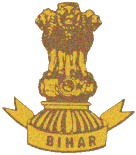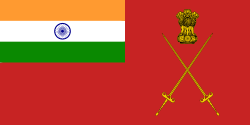Bihar Regiment
| Bihar Regiment | |
|---|---|
 Regimental Insignia of the Bihar Regiment | |
| Active | 1941–Present |
| Country |
|
| Branch | Army |
| Type | Infantry |
| Size | 20 Battalions |
| Regimental Centre | Danapur Cantonment, Patna |
| Motto(s) | Karam Hi Dharam (Work is Worship) |
| War Cries |
Jai Bajrang Bali (Victory to Bajrang Bali) Birsa Munda Ki Jai (Victory to Birsa Munda)[1] |
| Engagements |
Burma Campaign, World War II Indo-Pakistani War of 1947 Indo-Pakistani War of 1965 Indo-Pakistani War of 1971 Kargil War |
| Decorations | 3 Ashoka Chakras, 1 Maha Vir Chakra |
| Battle honours |
Post Independence |
| Commanders | |
| Colonel of the Bihar Regiment | Lt Gen Amarjeet Singh[2] |
| Notable commanders |
Lt Gen Sant Singh, Lt Gen K S Mann, Lt Gen A R K Reddy, Lt Gen O S Lohchab, Lt Gen Balbir Singh, Brig SC Johar, Col Umesh Kumar Bojha. |
| Insignia | |
| Regimental Insignia | The Ashoka Lion |
The Bihar Regiment is an infantry regiment of the Indian Army. The regiment can trace its origins back to the British Indian Army. The Bihar Regiment was formed in 1941 by regularising the 11th (Territorial) Battalion, 19th Hyderabad Regiment, and raising new battalions. The Bihar Regimental Centre (BRC) is located at Danapur Cantonment, the second oldest cantonment of India.
Bihari martial tradition
The martial tradition of Bihar troops in the era of British rule traces its origins to the sepoy battalions raised in 1757 by Lord Clive of the British East India Company at Patna.[3] These were formed by the men from the Bhojpur region of Bihar. Their success in combat impressed Mir Kasim, who began raising units trained in western combat techniques. Bihari battalions raised by Mir Kasim defeated the British in some engagements. The Bihari, or Purbiya, soldiers thereafter made up the backbone of the Bengal Infantry of the British Colonial Army. They mainly belonged to the Rajput and Bhumihar castes.[4]
They were not only excellent soldiers, but also quick to learn and apply the tactical drills with initiative. They were disciplined when led by good officers, but capable of hostility when their beliefs and customs were disregarded. The Indian Rebellion of 1857 against the introduction of greased cartridges, was led by Bihari troops, who preferred being blown by the guns to losing their faith. Biharis thereafter were not encouraged to enter military service by the British until after World War I.[5]
History
The Bihar Regiment was formed in 1941 during World War II by regularising the 11th (Territorial) Battalion, 19th Hyderabad Regiment as the 1st Battalion Bihar Regiment. The 2nd Battalion was raised in 1942.
Bihar Regiment in World War II
The newly raised 1 Bihar saw action in the Burma Campaign, winning battle honours for gallant actions at Haka and Gangaw. 2 Bihar formed part of Operation Zipper for the reoccupation of British Malaya.
History after Independence
Thereafter, both battalions participated in the Indo-Pakistani War of 1947 in the Kashmir Valley during 1948-49.
During the Indo-Pakistani War of 1965, 7 Bihar captured Bedori, paving the way for the capture of Haji Pir Pass.
By the start of the Indo-Pakistani War of 1971, the Regiment had expanded to 11 battalions. The sixth, seventh, eighth, tenth and eleventh battalions participated in operations in the eastern sector. 10 Bihar was conferred the theatre honour 'East Pakistan' for the capture of Akhaura. On 15 December 1971, a seaborne expedition was launched at Cox's Bazar to prevent Pakistani troops from escaping into Burma. 11 Bihar formed part of this amphibious task force. In the Western theatre of the war, 3 Bihar captured Wanjal.[6]
In the Spring of 1999, Pakistani soldiers posing as Kashmiri militants crossed the L.O.C. in Kargil and entered Indian territory. Operation Vijay was launched by the Indian Army to flush out the intruders. More than 10,000 soldiers and officers of the Bihar Regiment were deployed to Kargil.{[cn}} In a well planned operation in the Batalik sector, soldiers of 1 Bihar, in a fierce fight with the Pakistan Army, captured Point 4268 and Jubar Ridge in Kuker Thang area in the Batalik sector on the night 06/7 July 1999.
Units of the regiment have also served in UN Peacekeeping operations in Somalia (UNOSOM) and the Democratic Republic of Congo (MONUC).
Composition and Recruitment
The regiment gets its recruits from the Indian state of Bihar, Jharkhand, Odisha, Gujarat and Maharashtra.
Engagements
Deployments of units of the Bihar Regiment:
Units
Regimental Battalions:
- 1st Battalion
- 2nd Battalion
- 3rd Battalion
- 4th Battalion
- 5th Battalion
- 6th Battalion
- 7th Battalion
- 8th Battalion
- 9th Battalion
- 10th Battalion
- 11th Battalion
- 12th Battalion
- 14th Battalion
- 15th Battalion
- 16th Battalion
- 17th Battalion
- 18th Battalion
- 19th Battalion
- 20th Battalion
- 21st Battalion
- 4 RR Battalion
- 24 RR Battalion
- 47 RR Battalion
- 63 RR Battalion
- 120 Infantry Battalion (TA)
- 154 Infantry Battalion (TA)
Distinctions
Battle and theatre honours
- Battle honour Haka, awarded for Burma Campaign, World War II[7]
- Battle honour Gangaw, also awarded for Burma Campaign, World War II.[7]
- Theatre honour Burma 1942-45[7]
- Theatre honour East Pakistan 1971[7]
- Battle honour Batalik[8]
- Theatre honour Kargil[8]
Maha Vir Chakra
- Capt Gurjinder Singh Suri, MVC (Posthumous), 12 BIHAR, Kargil War
Vir Chakra
- Major Mariappan Saravanan (Posthumous), 1 BIHAR, Kargil War[9]
- Colonel M Ravi, 10 BIHAR, 1971 East Pakistan (Later Bangladesh)
- Lt Col K P R Hari, 1 BIHAR[10]
- Lt. Col. P.C. Sawhney, 10 BIHAR,1971 East Pakistan (Later Bangladesh)
- Maj (Later Maj.Gen.) D.P.Singh, 10 BIHAR,1971 East Pakistan (Later Bangladesh)
- Maj Harpal Singh Grewal (Posthumous), 8 BIHAR, 1971 East Pakistan (Later Bangladesh)[11]
- Sub Ghama Oraon, 1 BIHAR, Sri Lanka[12]
Ashoka Chakra
- Lieutenant Colonel Harsh Uday Singh Gaur (Posthumous), 10 Bihar, Baramulla district, 1994[13]
- Lieutenant Colonel Shanti Swaroop Rana (Posthumous), 3 Bihar, Kupwara district, 1997[14]
- Major Sandeep Unnikrishnan (Posthumous), 7 Bihar (on deputation to NSG), Operation Black Tornado
References
- ↑ "The Bihar Regiment". Bharat Rakshak. Archived from the original on 20 February 2014. Retrieved 2 August 2014.
- ↑ "104 recruits inducted into Bihar Regiment". The Times of India. TNN. 24 January 2018. Retrieved 1 February 2018.
- ↑ "Official Website of Indian Army". Archived from the original on December 16, 2010. Retrieved 26 November 2014.
- ↑ Ernst, Waltraud; Pati, Biswamoy, eds. (28 November 2007). India's Princely States: People, Princes and Colonialism. Routledge. p. 57. ISBN 978-0-415-41541-5. Retrieved 28 August 2016.
- ↑ pp20, The Indian Mutiny: 1857, Saul David
- ↑ John Pike. "Bihar Regiment". Retrieved 26 November 2014.
- 1 2 3 4 Singh, Sarbans (1993). Battle Honours of the Indian Army 1757 - 1971. New Delhi: Vision Books. p. 328. ISBN 8170941156.
- 1 2 "History of the Regiment". Official Website of the Indian Army. Retrieved 19 September 2018.
- ↑ "Major Saravanan Memorial Trust". Retrieved 26 January 2015.
- ↑ Staff Reporter (9 April 2010). "Surrendered ultras get training certificates". The Assam Tribune. Archived from the original on 8 April 2014. Retrieved 28 August 2016.
- ↑ "Vir Chakra (VrC), Awardee: Maj Harpal Singh Grewal, VrC @ TWDI". twdi.in. Retrieved 2016-11-21.
- ↑ "Vir Chakra (VrC), Awardee: PA Nk Ghama Oraon, VrC @ TWDI". www.twdi.in. Retrieved 2016-11-21.
- ↑ "The Bihar Regimental Association". Retrieved 26 January 2015.
- ↑ "Lt Col Shanti Swarup Rana". Indian Martyr. Archived from the original on 2012-01-09. Retrieved 2011-12-29.
